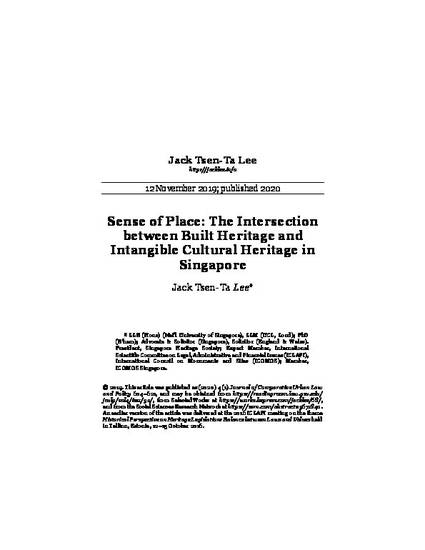
Article
Sense of Place: The Intersection Between Built Heritage and Intangible Cultural Heritage in Singapore
Journal of Comparative Urban Law and Policy
(2020)
Abstract
Built heritage in Singapore is safeguarded through two legal regimes, one relating to national monuments declared under the Preservation of Monuments Act (Chapter 239, 2011 Revised Edition), and the other relating to conservation areas declared under the Planning Act (Cap 232, 1998 Rev Ed). In contrast, no particular legal protection exists for intangible cultural heritage. Considering examples such as tomb inscriptions and rituals for honouring the deceased at Bukit Brown Cemetery, this article explores how built heritage can be secured and enriched by giving greater recognition and protection in international and domestic law to the intangible cultural heritage associated with it. There is also scope for built heritage to be used as a means of protecting intangible cultural heritage.
Keywords
- built heritage,
- intangible cultural heritage,
- Singapore,
- heritage law
Disciplines
Publication Date
August, 2020
Publisher Statement
This article was published as (2020) 4 (1) Journal of Comparative Urban Law and Policy 604–621, and may be obtained from https://readingroom.law.gsu.edu/jculp/vol4/iss1/32/, and from the Social Sciences Research Network at https://ssrn.com/abstract=3671840. An earlier version of the article was delivered at the 2016 ICLAFI meeting on the theme Historical Perspective on Heritage Legislation: Balance between Laws and Values held in Tallinn, Estonia, 12–15 October 2016.
Citation Information
Jack Tsen-Ta Lee. "Sense of Place: The Intersection Between Built Heritage and Intangible Cultural Heritage in Singapore" Journal of Comparative Urban Law and Policy Vol. 4 Iss. 1 (2020) p. 604 - 621 ISSN: 2576-4039 Available at: http://works.bepress.com/jacklee/68/
